The 20 Most Common Nut Trees to Grow in Your Garden

Step into a world where your garden becomes a treasure trove of nutty delights. From the timeless elegance of almond trees to the exotic marvels of Brazil nut trees, each variety is a unique chapter in the story of your outdoor haven. Join us on a journey through lush landscapes and diverse flavors as we explore the captivating universe of nut trees, transforming your backyard into a symphony of taste, texture, and natural beauty.
Why do you need to Grow Nut Trees in Your Garden? 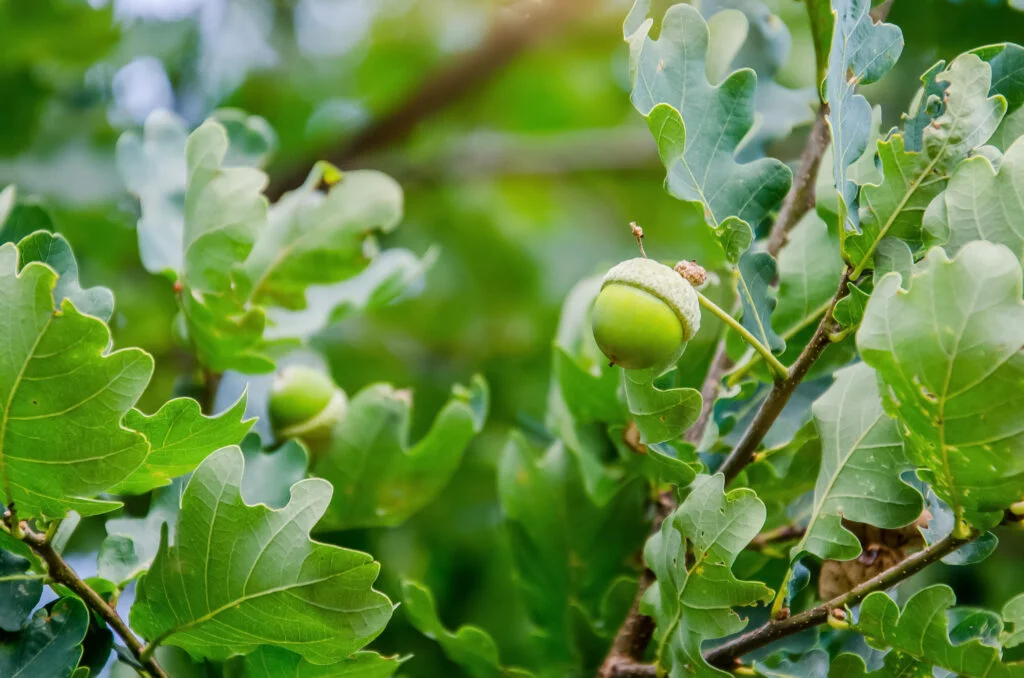
Embarking on the journey of growing nuts in your garden isn’t just a horticultural decision – it’s a delightful adventure with many benefits.
- Nutritional Powerhouses:Nuts contain essential nutrients, including healthy fats, protein, vitamins, and minerals. Incorporating homegrown nuts into your diet provides a direct and reliable source of these nutritional powerhouses. Each variety, from almonds to walnuts, brings a unique set of health benefits to your table.
- Garden Aesthetics:Nut trees aren’t just providers of nourishing treats; they also contribute to your garden’s visual appeal. With their lush foliage, distinctive shapes, and sometimes vibrant blooms, nut trees add a touch of elegance and greenery to your outdoor space.
- Sustainability at Home:Growing your nuts aligns with sustainable practices. By cultivating nut trees in your garden, you reduce the need for commercially sourced nuts, often shipped from faraway places. This localized approach contributes to a more sustainable and eco-friendly lifestyle.
- Unique Varieties for Every Taste:The world of nuts is incredibly diverse. From the creamy delights of macadamias to the earthy richness of chestnuts, there’s a nut variety to suit every taste bud. Growing nuts at home allows you to experiment with different flavors, ensuring a personalized and enriching culinary experience.
- Connection to Nature:Nurturing nut trees fosters a deeper connection to nature. Witnessing the growth and development of these trees, from delicate blossoms to bountiful harvests, creates a sense of appreciation for the cycles of life. It’s a grounding and fulfilling experience that enriches your connection to the natural world.
- Seasonal Delights:Many nut trees offer seasonal delights, such as the joy of harvesting pecans in the fall or cracking open fresh walnuts in late summer. The anticipation of these seasonal treasures adds a delightful rhythm to your gardening calendar, making each season in your garden unique and rewarding.
Choosing Nut Trees for Your Garden
Ready to add a nutty touch to your garden? Choosing suitable nut trees involves considering various factors to ensure a flourishing and delicious harvest. Let’s navigate the world of nut trees together!
- Climate Compatibility:Start by understanding the climate of your region. Different nut trees thrive in specific climates. For example, almonds and pistachios prefer arid climates, while chestnuts and hazelnuts flourish in temperate areas.
- Space Considerations:Evaluate the available space in your garden. Nut trees vary in size, from compact hazelnut bushes to expansive walnut and pecan trees. Consider the mature size of the trees to avoid overcrowding and to ensure each tree has ample space to grow and bear fruit.
- Flavor Preferences:Each type of nut brings its distinct flavor profile. Consider your taste preferences when choosing nut trees for your garden. Whether you love the rich taste of walnuts, the buttery notes of macadamias, or the sweet crunch of almonds, select varieties that align with your palate.
- Pollination Requirements:Some nut trees, like pecans and walnuts, require cross-pollination for successful fruiting. Others, such as almonds and filberts, are self-pollinating. Understand the pollination requirements of your chosen nut trees and ensure you have the necessary pollinators or compatible varieties for a fruitful harvest.
- Harvesting Time:Different nut trees have distinct harvesting times. Consider when you’d like to enjoy the fruits of your labor. For example, pecans are typically harvested in the fall, while almonds are ready for harvest in late summer.
- Disease Resistance:Check the disease resistance of the nut tree varieties you’re considering. Some trees, like certain chestnut varieties, are known for resisting specific diseases. Choosing disease-resistant varieties can help maintain a healthy and thriving nut orchard.
- Soil Quality:Nut trees have specific soil preferences. Conduct a soil test to ensure your garden soil meets the requirements of your chosen nut trees. Whether it’s well-draining almond or slightly acidic soil for blueberries, catering to your nut trees’ soil needs enhances their overall health.
Varieties of Nut Trees to Grow in Your Garden
Transform your backyard into a nut-rich oasis with these 20 common nut trees that promise a bountiful harvest.
- Almond Trees (Prunus dulcis):
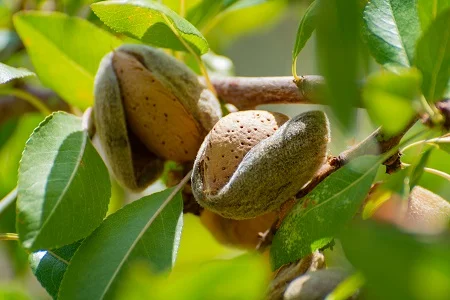 Elevate your backyard with almond trees’ timeless elegance and nutritional richness. These classic favorites thrive in Mediterranean climates, bringing a touch of sophistication to regions with warm, dry summers and mild winters. Your garden becomes a haven for both beauty and health.
Elevate your backyard with almond trees’ timeless elegance and nutritional richness. These classic favorites thrive in Mediterranean climates, bringing a touch of sophistication to regions with warm, dry summers and mild winters. Your garden becomes a haven for both beauty and health. - Walnut Trees (Juglans spp.):
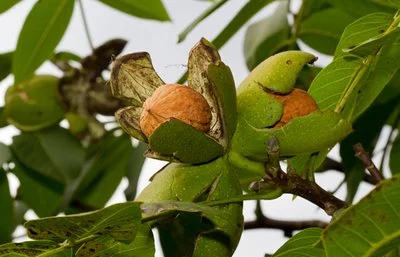 Shade and abundance unite with walnut trees, offering varieties like the robust black walnuts and the classic English walnuts. Not just providers of generous harvests, these trees become natural architects, crafting incredible retreats beneath their leafy branches.
Shade and abundance unite with walnut trees, offering varieties like the robust black walnuts and the classic English walnuts. Not just providers of generous harvests, these trees become natural architects, crafting incredible retreats beneath their leafy branches. - Pecan Trees (Carya Illinoinensis):
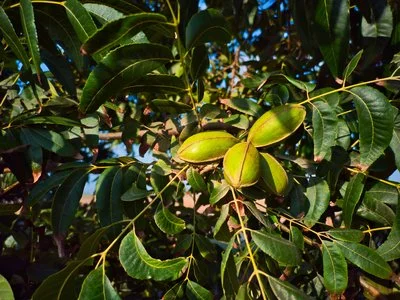 Marvel at the fast-paced growth of pecan trees, enchanting you and the local wildlife. These majestic wonders flourish in warm climates, creating a symphony of growth that resonates through your garden, season after season.
Marvel at the fast-paced growth of pecan trees, enchanting you and the local wildlife. These majestic wonders flourish in warm climates, creating a symphony of growth that resonates through your garden, season after season. - Hazelnut Trees (Corylus avellana): Embrace the whimsical growth and versatile nutty delights of hazelnut trees. With their playful branches and flavorful offerings, these trees turn your garden into a playground of tastes and textures, perfect for culinary adventures.
- Macadamia Nut Trees (Macadamia integrifolia):
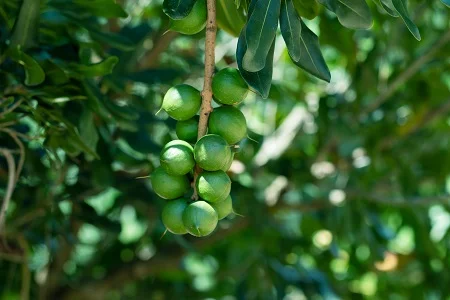 Infuse the buttery wonders of the Australian outback into your garden with macadamia nut trees. These trees, native to Australia, bring a taste of down-under luxury to your outdoor space, turning it into a haven of indulgence.
Infuse the buttery wonders of the Australian outback into your garden with macadamia nut trees. These trees, native to Australia, bring a taste of down-under luxury to your outdoor space, turning it into a haven of indulgence. - Brazil Nut Trees (Bertholletia excelsa):
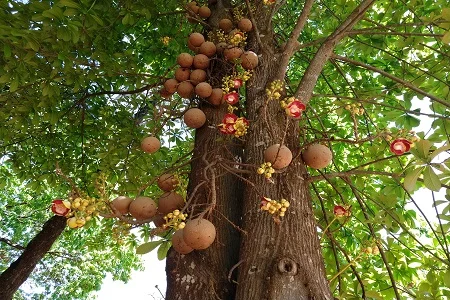 Unleash the exotic marvels of the Amazon rainforest right in your backyard with Brazil nut trees. These captivating giants contribute to your garden’s biodiversity and transport you to the lush realms of South America.
Unleash the exotic marvels of the Amazon rainforest right in your backyard with Brazil nut trees. These captivating giants contribute to your garden’s biodiversity and transport you to the lush realms of South America. - Pistachio Trees (Pistacia vera):
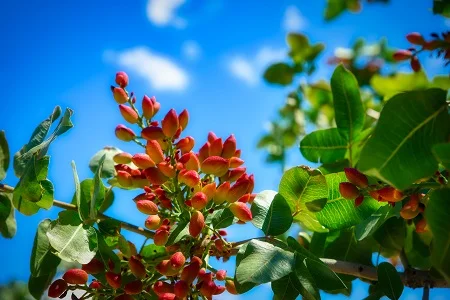
- Add vibrancy and flavor to your garden with the vibrant green gems of pistachio trees. Beyond their ornamental appeal, these trees bring color and taste, turning your outdoor space into a visual and culinary delight.
- Cashew Trees (Anacardium Occidentale):
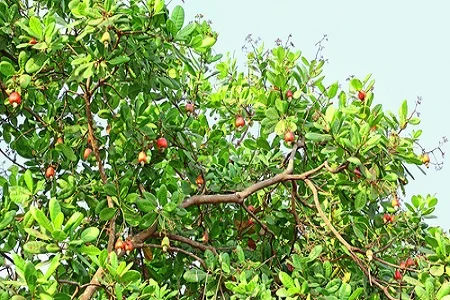 Transform your garden into a treasure trove with the tropical allure of cashew trees. These trees add a touch of tropical beauty to your outdoor space and are known for their delicious cashew nuts.
Transform your garden into a treasure trove with the tropical allure of cashew trees. These trees add a touch of tropical beauty to your outdoor space and are known for their delicious cashew nuts.
10. Pine Nut Trees (Pinus spp.):  Delicate and delicious, slender beauties known as pine nut trees offer more than just nuts – they uniquely charm your garden. Let these trees symbolize grace and flavor amidst your green landscape.
Delicate and delicious, slender beauties known as pine nut trees offer more than just nuts – they uniquely charm your garden. Let these trees symbolize grace and flavor amidst your green landscape.
11. Chestnut Trees (Castanea spp.):  Fall in love with the autumnal delights of chestnut trees. As nostalgia fills the air, your backyard becomes a haven of memories and warmth, making every fall a season to cherish.
Fall in love with the autumnal delights of chestnut trees. As nostalgia fills the air, your backyard becomes a haven of memories and warmth, making every fall a season to cherish.
12. Filbert Trees (Corylus maxima):  Also known as European hazelnuts, Filbert trees add a flavorful twist to your nut collection. Their presence in your garden is a testament to nature’s rich and diverse palette of nut varieties.
Also known as European hazelnuts, Filbert trees add a flavorful twist to your nut collection. Their presence in your garden is a testament to nature’s rich and diverse palette of nut varieties.
13. Butternut Trees (Juglans cinerea):  Hailing from North America, butternut trees offer more than just buttery-flavored nuts. They bring a touch of the continent’s natural heritage to your garden, creating a connection to the landscapes of the New World.
Hailing from North America, butternut trees offer more than just buttery-flavored nuts. They bring a touch of the continent’s natural heritage to your garden, creating a connection to the landscapes of the New World.
14. Black Walnut Trees (Juglans nigra):  Dive into the world of distinctive flavor and sturdy wood with black walnut trees. These majestic trees, native to North America, become storytellers of the land, weaving tales of strength and resilience.
Dive into the world of distinctive flavor and sturdy wood with black walnut trees. These majestic trees, native to North America, become storytellers of the land, weaving tales of strength and resilience.
14. English Walnut Trees (Juglans regia):  Embrace English walnut trees’ mild and pleasant taste. As classic varieties, they become culinary companions, offering a timeless flavor that elevates your garden experience.
Embrace English walnut trees’ mild and pleasant taste. As classic varieties, they become culinary companions, offering a timeless flavor that elevates your garden experience.
15. Ginkgo Trees (Ginkgo biloba):  Stand out with unique fan-shaped leaves and edible nuts from ginkgo trees. These botanical wonders bring aesthetic appeal to your garden and provide a distinctive addition to your nut tree collection.
Stand out with unique fan-shaped leaves and edible nuts from ginkgo trees. These botanical wonders bring aesthetic appeal to your garden and provide a distinctive addition to your nut tree collection.
16. Hickory Trees (Carya spp.):  Explore the diverse offerings of various hickory species, providing tasty nuts and hardwood for your garden projects. Let the versatility of hickory trees become a cornerstone of your outdoor space.
Explore the diverse offerings of various hickory species, providing tasty nuts and hardwood for your garden projects. Let the versatility of hickory trees become a cornerstone of your outdoor space.
17. Chinese Chestnut Trees (Castanea mollissima):  Infuse Asian charm with sweet and flavorful chestnuts from Chinese chestnut trees. These enchanting additions turn your garden into a cultural tapestry, blending global influences seamlessly.
Infuse Asian charm with sweet and flavorful chestnuts from Chinese chestnut trees. These enchanting additions turn your garden into a cultural tapestry, blending global influences seamlessly.
18. American Beech Trees (Fagus grandifolia):  American beech trees, known for their beech nuts and distinctive smooth bark, symbolize tradition in your garden and link your space to North America’s natural heritage.
American beech trees, known for their beech nuts and distinctive smooth bark, symbolize tradition in your garden and link your space to North America’s natural heritage.
19. Sweet Chestnut Trees (Castanea sativa):  Introduce European elegance with lovely chestnut trees offering large, sweet nuts. These trees, reminiscent of ancient landscapes, bring your garden a touch of continental charm.
Introduce European elegance with lovely chestnut trees offering large, sweet nuts. These trees, reminiscent of ancient landscapes, bring your garden a touch of continental charm.
20. Acorn Oak Trees (Quercus spp.):  While primarily known for acorns, some oak species produce edible nuts, adding a layer of diversity to your nut tree collection. Oaks are timeless symbols of strength and endurance, casting their shade over your garden for generations.
While primarily known for acorns, some oak species produce edible nuts, adding a layer of diversity to your nut tree collection. Oaks are timeless symbols of strength and endurance, casting their shade over your garden for generations.
The Bottom Line
As we wrap up our exploration of nut trees, envision the coming seasons in your transformed garden. The elegance of almond blossoms, the robust stature of walnut trees, and the exotic allure of Brazil nut trees—all converge to create a haven of abundance. Embrace the joy of cultivating diverse nut trees, each contributing its unique charm to your outdoor space. Your garden is now a sanctuary, not just for plants but for a rich tapestry of flavors and memories.
Ready to embark on your nutty adventure? It’s time to bring the flavors of almond, walnut, pecan, and more to your garden. Dive into the rewarding journey of nurturing nut trees and watch your outdoor space transform into a sanctuary of taste and beauty. Whether you’re a seasoned gardener or a novice with a green thumb, the world of nut trees awaits your touch. Plant, nurture, and harvest the bounty – let your garden flourish with the richness of nutty treasures!












